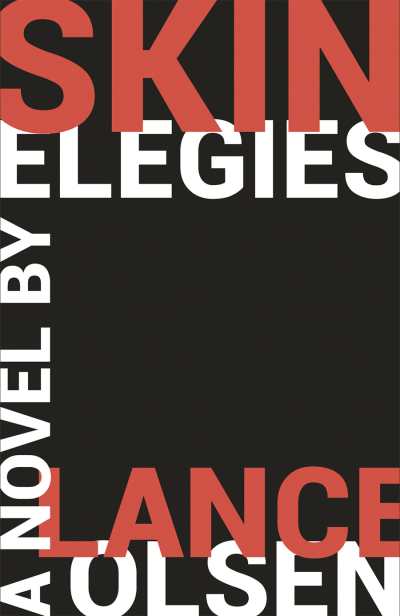Reviewer Eileen Gonzalez Interviews Lance Olsen, Author of Skin Elegies

When we launched Foreword This Week all those years ago, the mission we assigned ourselves was to connect Foreword reviewers with the most unforgettable authors we cover in the magazine—to banter and challenge and jovially engage in high level literary conversations. We had no idea how thrilling many of these interviews would turn out to be.

Well, the Eileen and Lance show below sets a new bar. Skin Elegies earned Eileen’s highest praise—“spellbinding,” “stunning,” “brilliant”—in her starred review for our November/December issue, and when we pitched the interview, she responded with an emphatic “I’m definitely up for that!”
Enjoy.
Your book switches between multiple stories that, at first, seem to have little in common. Why did you pick these stories in particular? What was it about them that drew you to them?
I think of Skin Elegies as a constellation novel, a term coined by Olga Tokarczuk to describe her astonishing one—Flights. That is, it’s built out of many narrative fragments that don’t easily narrativize the world, don’t move from beginning to end in a smooth arc, refuse to reinvent previous narrative strategies. Another way of saying this: I’m drawn to writing (and reading) as a nomadic activity.
The stories that comprise Skin Elegies were ones that struck me as capturing pivotal moments in our postwar cultural consciousness, moments that made us all a little bit more who we are in 2021. There were many others, of course, I could have chosen, but each of these has special emotional significance for me for one reason or another. John Lennon’s murder, for instance: he was and remains one of my creative and iconoclastic models. Losing him shook me to the core in my mid-twenties.
While the stories are based on true events, by necessity, you’ve had to take liberties with some details, such as people’s inner thoughts and motivations. What, to you, are the challenges and benefits of blending fact and fiction in this way?
I seem to be drawn to historical events—the Challenger disaster, say, or the final hours of World War Two in Berlin—that we all know superficially, abstractly, from the outside. What fiction can do that other modes of documentary writing can’t is situate those events in particular people rather than foggy generalities, situate them in particular subjectivities, who—like most of us—weren’t central to the event described. History experienced through the senses, through the emotions, is a very different category of writing (and a fraught one, to be sure) compared to academic or journalistic renderings.
That said, for decades I’ve been interested in pastness as problem. Who, for instance, gets to tell yesterday, from what vantage point, and to what ends? History is an intricate, troubled subset of fiction in the sense that one controls it through various narrative choices and conventions. The question for a fiction writer approaching that terrain is: how can we re-write and re-right history by employing modes that illuminate our biases and blindnesses, which always-already suffuse our understanding of moments to which we can only have inferred access through a welter of archival resources?
It’s very impressive how you use different writing styles for each character. For example, the Mark David Chapman sections ramble a lot and are filled with dark, angry thoughts, while the Columbine sections are more abstract and fragmentary. Was it difficult to embody such diverse tones?
In his often-overlooked discussion of the novel, the critic Leonard Lutwack distinguishes between two modes of presentation in fiction: uniform and mixed style. Texts employing the former—Lutwack cites Pamela and The Ambassadors as examples—signal the presence of a writer’s conviction about a single, unambiguous, coherent view of reality. A uniform style ensures “that no different adjustment to language and viewpoint will be demanded from the reader than that established at the outset.”
Conversely, texts that employ a mixed style—Ulysses and As I Lay Dying leap to mind—signal a writer’s lack of conviction about a single, unambiguous, coherent view of reality. Lutwack: “A mixture of styles has the effect of making the reader pass through a succession of contradictory and ambiguous attitudes. It offers no sure stylistic norm by which the reader may orient him or herself permanently to the fiction and to the point of view of the author.”
The idea behind that idea for me is this: That form (and style is part of form) isn’t simply a tool one uses. Rather, every form, every style suggests a philosophy, a vision of the world, and I’ve always connected with what mixed-style novels imply about how reality comes to us. I love to adopt different voices to suggest different ways of seeing, different ways of being in the world.
I wrote all nine narratives as you see them in Skin Elegies, interrupting each other, harmonizing with each other, contradicting each other, growing like barnacles on a rock or wreck. So it was difficult inventing and reinventing the different voices … but that’s exactly what I adore about the process. Imagine: we fiction writers get to inhabit the consciousnesses of other humans in order to try to understand the rhythms of their being. What could be more challenging and rewarding?
It was interesting how you didn’t go for the obvious subject matter for the sections that take place on 9/11. Is there a reason why you had that particular narrative occur on that particular date?
There’s so much fiction and nonfiction that head-on addresses 9/11, and any of us who were alive at the time have witnessed that tear in reality’s fabric replayed over and over again on various media. But outside the US, 9/11 often seems to have happened on a different scale, at a farther remove. And even as the event happened, other people in other places went on with their living and dying because there was no choice. I wanted to place our country’s moment of historical rupture in a defamiliarized context—here, someone undergoing assisted suicide in
Switzerland, who had a radically other cluster of concerns that day, who had a radically other vantage point on death.
The sections that take place in the future center on the introduction of a new way for humans to be and connect. This feels very relevant with the rise of smartphones and digital communication—and especially now, with the pandemic making digital connections more important than ever. But these sections feel almost ominous—was that your intention? Do you have any strong opinions about how the nature of human connection is evolving?
One of the fractured stories in Skin Elegies deals with the day the internet was turned on for the first time: 29 October 1969. That’s when a grad student, Charley Kline, who was essentially doing a homework assignment at UCLA in collaboration with a young computer programmer, Bill Duvall, up at the Stanford Research Institute, connected their computers over the phoneline and began to communicate. What blows me away is that neither understood what they had just done. No one else in the world had a clue that our digital consensual hallucination had begun.
At the same time as I was reading about that, I was also reading about mind-upload technologies—the attempt now underway both in Russia and here at life extension by housing our thoughts, our personalities (sans bodies) in a supercomputer. Skin Elegies is therefore—in my mind, at least, from one perspective—a story about refugeeism in its largest sense. What are the implications of this for our concept of self, the body, place, even death? What does such longing on the part of some teach us about what we think being us now, here, is all about at the end of the day?
The space between Kline and Duvall’s flick of the switch in 1969 and the first uploaded mind—that is, the space we are inhabiting right now—is a strange and terrible and fascinating one to me, with its illusion of connection (think Facebook, Twitter, Instagram, all the screens that pretend to connect us in ways that actually separate us, drive us farther and farther away from intimate human contact), with its proliferation of data without meaning.
Without giving anything away, the last line and the way you used it is really unforgettable. Where did that come from? What does it—and the story as a whole—mean to you?
Speaking of connection, at the heart of the heart of Skin Elegies, I wanted to mine a single metaphor to see how it opened up: human hands touching—which is to say, human beings bonding, really bonding, however fleetingly, however fragilely. In one form or another, that image appears in each of the nine narratives that comprise the novel. It asks us to remind ourselves, I hope, what this thing called being human actually entails.
Eileen Gonzalez
